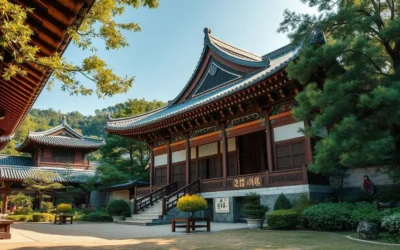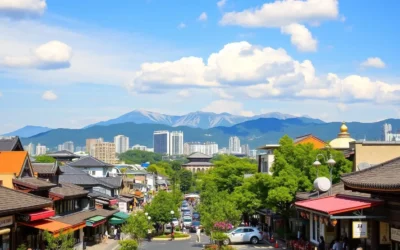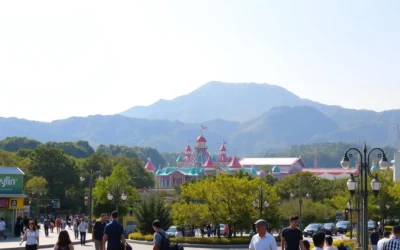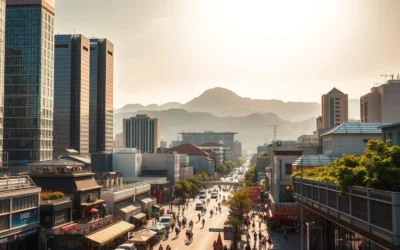✓ Accommodations✓ Flights✓ Rental Cars
You’re about to discover the fascinating linguistic landscape of Jeju Island, the southernmost part of South Korea. This island is not only the country’s largest island but also a place where two official languages coexist, making it linguistically unique.
The Jeju Province, officially known as Jeju Special Self-Governing Province, comprises eight inhabited and 55 uninhabited islands. The vast majority of residents are bilingual, speaking both Korean and the indigenous Jejueo language. As you explore this article, you’ll gain insights into the historical development of languages in Jeju, from the ancient Tamna Kingdom to modern times, and understand why UNESCO recognizes Jejueo as an endangered language.
The Linguistic Landscape of Jeju Province
As you explore Jeju Province, you’ll discover a unique linguistic landscape shaped by its history and geography. Jeju Island, being a distinct geographic entity, has developed a linguistic identity that is separate from mainland South Korea.
Geographic and Administrative Context
Jeju Province is a self-governing province of South Korea, comprising the island of Jeju and several smaller surrounding islands. The island’s relative isolation has contributed to the development of its unique linguistic features. You can see how the geographic context has influenced the language spoken on the island.
The administrative status of Jeju as a special self-governing province has also played a role in shaping its linguistic landscape. This status has allowed for a degree of autonomy in cultural and educational matters, which in turn has impacted language use and preservation.
| Geographic Feature | Linguistic Impact |
|---|---|
| Island Isolation | Development of unique linguistic features |
| Administrative Autonomy | Influence on language use and preservation |
Overview of Language Diversity in Jeju
You’ll discover that Jeju Province has a fascinating linguistic diversity, primarily characterized by two languages: Standard Korean and Jejueo. Standard Korean is the official national language, while Jejueo is the indigenous language of the island. Unlike other Korean regional dialects, Jejueo is considered by many linguists to be a separate language rather than just a dialect, with UNESCO recognizing it as critically endangered.
The language situation in Jeju reflects the island’s unique history and relative isolation from mainland South Korea. Most residents of Jeju today are bilingual, speaking both Standard Korean and varying degrees of Jejueo depending on their age and background. This linguistic diversity creates a unique cultural identity for Jeju Island, distinguishing it from other regions of South Korea.
Historical Development of Languages in Jeju
As you explore the historical context of Jeju Island, you’ll discover how its language has evolved over time. The island’s unique linguistic identity has been shaped by its complex history, including periods of isolation, external rule, and cultural exchange.
From Tamna Kingdom to Modern Era
Jeju Island, known historically as Tamna, has a distinct history that dates back to ancient times. The island was once an independent kingdom before it came under the rule of the Joseon Dynasty in the 15th century. During the Joseon rule, particularly in the 17th century, King Injo issued an edict that prohibited islanders from traveling to the mainland, leading to nearly 200 years of isolation. This period significantly contributed to the divergence of the Jeju language from mainland Korean.
The islanders staged several major uprisings against the mainland rule, including the Kang Je Geom Rebellion in 1862 and the Lee Jae Su Rebellion in 1901. These rebellions reinforced a separate island identity that was reflected in the use of language. Later, during the Japanese colonial period from 1910 to 1945, Japanese became the language of education and government, while Jejueo was relegated to private use.
Evolution of Linguistic Identity
The linguistic identity of Jeju Island has evolved significantly over the centuries, influenced by its history and cultural exchanges. The language spoken on the island today is a testament to its rich history, reflecting both its independence and the various periods of external influence.
| Period | Event | Impact on Language |
|---|---|---|
| 15th Century | Joseon Dynasty Rule | Initial influence of mainland Korean |
| 17th Century | Travel Ban by King Injo | Divergence from mainland Korean |
| 1910-1945 | Japanese Colonial Rule | Introduction of Japanese in education and government |
The history of Jeju Island is a crucial part of understanding its linguistic landscape. The people of Jeju have maintained their unique cultural and linguistic identity despite centuries of external influences.
Standard Korean (Pyojuneo) in Jeju Province
As you explore Jeju Province, you’ll notice the prevalence of Standard Korean, also known as Pyojuneo. This language form is not only official but also widely understood and used across the island.
Official Status and Usage
Standard Korean is the language of officialdom, education, and media in Jeju Province. Its widespread use is a result of South Korea’s nation-building efforts during the mid-20th century, which aimed to standardize the language across the country. About 70% of the vocabulary used in Standard Korean is derived from the Seoul dialect, making it the most comprehensible form of the language throughout South Korea, including Jeju Island.
The use of Standard Korean is pervasive in formal settings, such as government communications, education, and national media. This has contributed to its widespread understanding and adoption among the population, including the residents of Jeju Province.
| Domain | Usage of Standard Korean |
|---|---|
| Government and Official Communications | High |
| Education | High |
| Media | High |
| Daily Conversations Among Younger Generations | Increasing |
Influence of Seoul Dialect
The Seoul dialect has had a significant influence on the Standard Korean spoken in Jeju Province. This influence is largely due to the pervasive reach of national media and the education system, which have been instrumental in disseminating the Seoul dialect as the standard form of Korean.
Young people in Jeju increasingly adopt Seoul-influenced pronunciation and vocabulary, especially if they have studied or worked on the mainland or consume mainstream South Korean media. This has led to a growing linguistic homogenization across South Korea, with younger generations in Jeju often speaking Standard Korean with minimal distinction from their mainland counterparts.
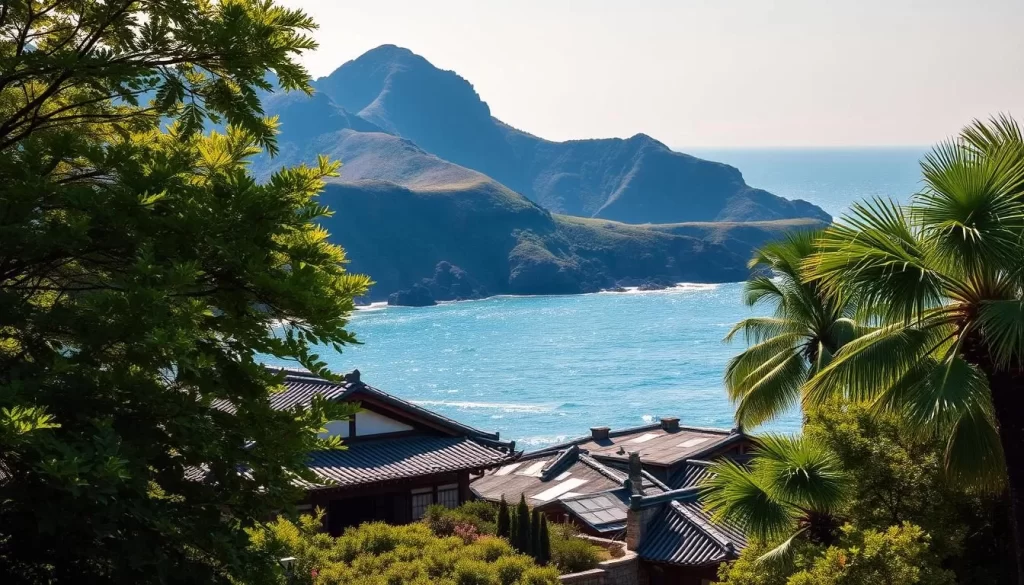
The influence of the Seoul dialect on Standard Korean in Jeju Province is a reflection of the broader linguistic trends in South Korea. As mobility between the island and the mainland increases, along with the continued popularity of Korean popular culture, the dominance of Standard Korean is likely to persist.
Jejueo: The Indigenous Language of Jeju Island
As you explore the linguistic landscape of Jeju Island, you’ll discover the unique characteristics of Jejueo, the indigenous language of this distinct island in South Korea. Jejueo is a vital part of Jeju’s cultural identity, with a history that spans centuries.
UNESCO Recognition as Endangered Language
Jejueo has been recognized by UNESCO as an endangered language, highlighting the urgent need for preservation efforts. The language has been facing significant challenges, including the interruption of intergenerational transmission, which means that it is no longer being passed down naturally from parents to children.
Factors contributing to the decline of Jejueo include standardized education in Korean, migration patterns, media influence, and the historical trauma of the 1948 Jeju Uprising. These factors have dramatically reduced the number of fluent speakers over the past century.
Current Number of Speakers
Despite Jeju Island’s population of over 670,000 people, only about 5,000 to 10,000 individuals are considered fully fluent speakers of Jejueo. The demographic profile of these speakers is concerning, as virtually all fluent speakers were born before 1950 and are now in their 70s or older.
The current state of Jejueo speakers can be summarized in the following table:
| Category | Number | Age Group |
|---|---|---|
| Fluent Speakers | 5,000 – 10,000 | 70s and above |
| Island Population | 670,000+ | All ages |
Understanding the current state of Jejueo is crucial for developing effective preservation strategies. As the number of fluent speakers continues to diminish, efforts to document, teach, and promote the language are becoming increasingly important.
Linguistic Features of Jejueo
Jejueo, the indigenous language of Jeju Island, boasts distinct linguistic features that set it apart from the Korean language. As you explore Jejueo, you’ll discover its unique characteristics, shaped by the island’s history and cultural heritage.
Phonological Characteristics
One of the notable aspects of Jejueo is its phonological characteristics. The language has a distinct sound and pronunciation that differs from Standard Korean. For example, Jejueo retains many archaic sounds that have disappeared from the mainland Korean language. This makes it a valuable resource for linguistic research and a fascinating subject for language enthusiasts.
Grammatical Structures and Vocabulary
Jejueo’s grammatical structures and vocabulary are also noteworthy. The language lacks the complex honorifics and formalities found in Standard Korean, making it more egalitarian in its approach to social relationships. For instance, the formal greeting “annyeonghaseyo” in Standard Korean is simplified to “ban-gapsuda” in Jejueo. You’ll find that Jejueo’s vocabulary contains many unique words related to island life, fishing, and local customs, which are not found in Standard Korean.
Furthermore, Jejueo has borrowed words from various foreign languages, reflecting the island‘s history of cultural exchange. This linguistic diversity is a testament to Jeju Island’s strategic location and its role in international trade and cultural interactions. As you learn Jejueo, you’ll encounter interesting examples of language contact, with words borrowed from languages such as Japanese, Chinese, and Mongolian.
When you use Jejueo, you’ll notice its distinctive sentence-ending particles and verbal conjugations, which differ significantly from those in Standard Korean. This unique grammatical structure adds to the richness and diversity of the language, making it an important part of Jeju’s cultural identity.
Differences Between Jejueo and Standard Korean
As you explore the linguistic landscape of Jeju Island, you’ll notice significant differences between Jejueo and Standard Korean. While both are part of the Korean language family, they have evolved differently due to Jeju’s unique history and cultural identity.
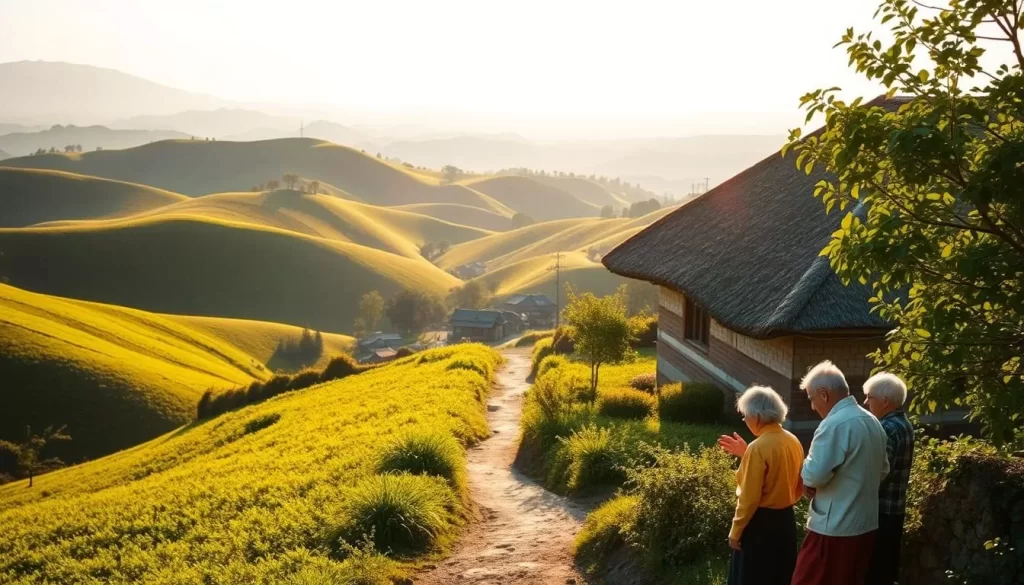
Pronunciation and Accent Variations
Jejueo has distinct pronunciation and accent variations compared to Standard Korean. The intonation patterns and stress on certain syllables in Jejueo can be quite different, reflecting the island’s cultural and historical context. For instance, the accent in Jejueo is often described as more melodic and varied, which can be attributed to the island’s geographic isolation.
These variations are not just limited to accent; they also extend to the phonological characteristics of the language. Certain sounds and sound combinations in Jejueo are either not found in Standard Korean or are used differently, adding to the richness of the language.
Vocabulary and Expression Differences
The vocabulary of Jejueo is another area where it significantly diverges from Standard Korean. For example, the formal greeting “annyeonghaseyo” in Standard Korean is expressed as “ban-gapsuda” in Jejueo. This difference is not isolated; many everyday items and concepts have different names in Jejueo.
| Concept | Standard Korean | Jejueo |
|---|---|---|
| Formal Greeting | annyeonghaseyo | ban-gapsuda |
| Father | abeoji | appé |
| Sea | baehae | gotil |
Jejueo retains many archaic words and has borrowed from foreign languages, reflecting Jeju Island’s historical interactions with other cultures. The differences in vocabulary are particularly notable in areas related to fishing, agriculture, and natural phenomena, highlighting the island’s unique environment and traditional livelihoods.
Cultural Significance of Jejueo
The indigenous language of Jeju, Jejueo, is a cornerstone of the island’s unique cultural heritage. For the residents of Jeju Island, Jejueo is not just a means of communication; it’s a vital part of their identity and cultural practices.
Heritage Connection
Jejueo is deeply connected to Jeju’s unique heritage, reflecting the island‘s history and traditions. The language is a window into the island’s past, offering insights into the lives and customs of its people. For instance, many elderly residents of Jeju consider Jejueo as a means to bond deeply with other residents, reinforcing social bonds and cultural identity.
Traditional Practices
Jejueo plays a crucial role in various traditional practices and customs on Jeju Island. You’ll find that:
- Traditional Jeju shamanic ceremonies (gut) incorporate chants and invocations in Jejueo, believed to be essential for their spiritual efficacy.
- The language is integral to traditional folk songs (minyo) and narrative performances that are part of cultural celebrations.
- Many traditional crafts and skills rely on specialized Jejueo terminology, precisely describing techniques and materials.
- Community gatherings and day-to-day customs among older islanders often incorporate Jejueo expressions, reinforcing social bonds.
These practices highlight the significance of Jejueo in maintaining the cultural culture and identity of Jeju Island. As you explore the use of Jejueo in daily life, it becomes clear that the language is not just a relic of the past but a living, breathing part of Jeju’s island life, used every day in meaningful ways.
Language and Identity in Jeju Province
Jeju Island’s unique linguistic landscape plays a significant role in shaping the identity of its residents. The language spoken by the people of Jeju is closely tied to their cultural heritage and sense of self.
Linguistic Identity Among Jeju Residents
The residents of Jeju Island have a distinct linguistic identity that is influenced by their history, culture, and geography. For the people of Jeju, language is not just a means of communication but also a symbol of their unique identity within South Korea. Living on a relatively isolated island has allowed Jeju to maintain some of its linguistic characteristics.
Generational Differences in Language Use
You’ll notice striking generational differences in language use on Jeju Island, with fluent Jejueo speakers almost exclusively found among those born before 1950, who are now in their 70s or older. The middle generation, roughly 40-60 years old, typically has passive knowledge of Jejueo. Young people on the island today generally speak Standard Korean as their primary language, with many having little to no functional knowledge of Jejueo. This shift has occurred over time, reflecting broader societal changes.
Preservation Efforts for Jejueo
The preservation of Jejueo, the indigenous language of Jeju Island, is a complex task that involves various stakeholders and strategies. Efforts to preserve Jejueo are underway through various initiatives.
Local Government Support
Local government bodies are providing support for Jejueo preservation through various means, including funding for cultural events and language programs. This support is crucial for the continuation of efforts to document and teach Jejueo on the island.
Community Initiatives
You’ll discover various community-based initiatives working to preserve Jejueo, led by different groups. The Jejueo Preservation Corporation is a key organization that coordinates documentation efforts and develops educational materials. Additionally, the annual Jeju Language Contest encourages people of all ages to learn and use Jejueo through competitive speech and performance events.
Educational programs are vital for the preservation of Jejueo. After-school language classes and specialized courses for adults are being offered to cater to different age groups and proficiency levels. Moreover, the development of smartphone applications and online resources is making it easier for people to learn Jejueo, enhancing the education system.
| Initiative | Description | Target Audience |
|---|---|---|
| Jejueo Preservation Corporation | Coordinates documentation and develops educational materials | General Public, Learners |
| Annual Jeju Language Contest | Competitive speech and performance events | All Ages |
| After-school Language Classes | Language education for children | Children |
| Smartphone Applications | Online resources for learning Jejueo on Jeju Island | General Public, Younger Generations |

The Annual Jeju Language Contest
Every year, the Jeju Language Contest brings together people from different generations to celebrate and preserve Jejueo, the indigenous language of Jeju Island. This event is a cornerstone in the efforts to maintain the linguistic heritage of the island.
A Brief History and Purpose
The Jeju Language Contest was initiated to promote the use and preservation of Jejueo. In 2011, the budget allocated for language preservation was 43 million won (approximately US$39,000), which was used for Internet broadcasting, teacher instruction, and prizes for the annual speech contest. The contest serves as a platform to encourage the community to engage with their linguistic heritage.
Impact on Language Preservation
The contest has had a significant impact on the preservation of Jejueo. Some of the key outcomes include:
- Creating a high-profile annual event that highlights the endangered status of Jejueo and brings attention to the need for its preservation.
- Identifying and documenting fluent speakers across various age groups, resulting in valuable audio and video recordings for future generations.
- Motivating individuals, particularly middle-aged residents, to learn and improve their Jejueo skills through prizes and recognition.
- Facilitating intergenerational language exchange, where older fluent speakers mentor younger participants, thus bridging the language gap between generations.
- Increasing public awareness about Jejueo preservation through media coverage, including internet broadcasting, which has helped secure community and government support for other preservation initiatives.
By engaging the community and encouraging the use of Jejueo, the contest plays a vital role in the preservation of the Jeju language and the cultural identity it represents. As the contest continues to grow, it remains a significant event on the island’s cultural calendar, promoting linguistic diversity and heritage.
Digital Preservation of Jejueo
You can explore how digital initiatives are preserving Jejueo for future generations. The digital preservation of Jejueo involves a comprehensive approach, leveraging technology to document and archive the language.
Smartphone Applications and Online Resources
The development of smartphone applications and online resources is a crucial aspect of digital preservation. These tools make it easier for people to learn and engage with Jejueo. For instance, language learning apps can provide interactive lessons and exercises, while online dictionaries and resources offer accessible references.
Key Features of Digital Resources:
- Interactive language lessons
- Audio and video recordings of native speakers
- Accessible online dictionaries and resources
Documentation Projects and Archives
Documentation projects are vital for creating detailed records of Jejueo. These projects involve recording fluent speakers, compiling grammatical descriptions, and developing lexical databases. The collaboration between researchers like William O’Grady and various institutions has been instrumental in this effort.
| Project Component | Description |
|---|---|
| Audio/Video Recordings | Capturing native speakers in various contexts |
| Grammatical Descriptions | Detailed analysis of Jejueo’s structure |
| Lexical Databases | Comprehensive vocabulary documentation |
These digital archives are designed to be accessible and useful for future generations, ensuring the long-term preservation of Jejueo.
Impact of Tourism on Language Use in Jeju
As part of the plans to turn Jeju into a “Free International City,” the island is experiencing a linguistic transformation. The growing number of international visitors has led to a shift in language use, particularly in tourist areas.
Language Adaptation for International Visitors
The increasing number of tourists has prompted businesses to adapt their language use to cater to international visitors. You can observe this in the multilingual signage and information systems found in popular tourist destinations like Seongsan Ilchulbong (Sunrise Peak) and the Jungmun Tourist Complex. These areas often feature information in multiple languages, including Korean, English, Chinese, and Japanese, to facilitate communication with visitors.
Linguistic Landscape in Tourist Areas
The linguistic landscape in Jeju’s tourist areas is characterized by a predominance of Standard Korean and foreign languages, with Jejueo being less visible. You can see this in the souvenir shops and markets, where products typically feature text in Standard Korean or English. Restaurant menus also follow this pattern, using Standard Korean with translations in other languages. However, some specialty shops have started to incorporate Jejueo phrases as a unique cultural element.
| Language Used | Tourist Areas | Local Businesses |
|---|---|---|
| Standard Korean | Predominant | Common |
| Jejueo | Rarely Used | Less Common |
| Foreign Languages | Frequently Used | Increasingly Used |
This multilingual environment creates a complex daily experience for local service workers, who must switch between languages throughout the day. As you explore Jeju Island, you can see how the island’s linguistic identity is evolving in response to tourism.
Jeju Province, South Korea: Official and Widely Spoken Languages Today
You might be surprised to learn that Jeju Province has a distinct linguistic identity that sets it apart from mainland South Korea. The province, which includes Jeju Island, has a unique cultural and linguistic heritage.
Current Language Policies
The official languages of Jeju Province are Jeju and Korean. Language policies in the province are designed to promote both the indigenous Jejueo language and Standard Korean. Efforts are being made to preserve Jejueo, which is recognized as an endangered language by UNESCO. The government has implemented policies to support the use of Jejueo in education and cultural activities.
Bilingualism and Language Practices
Bilingualism is common among the residents of Jeju Province, although it manifests differently across generations. Older residents are often bilingual in Jejueo and Standard Korean, while younger residents may be bilingual in Standard Korean and another foreign language, such as English. In practice, language use follows clear domains: Standard Korean is used in formal settings, education, and media, while Jejueo is typically reserved for informal conversations among older residents or cultural performances. Code-switching is also common, particularly among middle-aged and older residents.
The current language practice in Jeju Province reflects its position within the broader South Korean society, balancing local identity with national integration and international engagement. As you explore the linguistic landscape of Jeju, you’ll find that it offers a unique perspective on bilingualism and language preservation.
International Collaboration for Language Preservation
As you explore the efforts to save Jejueo, you’ll find that international collaboration is key. The preservation of this unique language requires a multifaceted approach that involves various stakeholders from around the world.
UNESCO’s Role in Protecting Jejueo
UNESCO plays a significant role in protecting Jejueo by recognizing it as an endangered language. This recognition not only highlights the language’s precarious status but also opens up opportunities for international collaboration. Linguist William O’Grady proposed a collaboration blueprint among several entities, including the Jeju Language Preservation Committee, UNESCO, the Smithsonian Institution, Jeju National University, and the University of Hawaii.
The plan emphasizes the need for written materials, Jejueo communities, administrators, and teachers fluent in Jejueo. By citing the Hawaiian language as an example, which was revitalized from having only about 300 speakers to being spoken by thousands, O’Grady’s proposal underscores the potential for successful language preservation through concerted efforts.
Academic and Research Partnerships
International academic partnerships are crucial for Jejueo preservation. Collaborations between Jeju National University and institutions like the University of Hawaii bring valuable expertise and resources to the table. These partnerships focus on documentation, teaching material development, and training language instructors who can effectively teach Jejueo to new generations.
- Research partnerships help ensure that preservation efforts are based on sound linguistic principles and effective teaching methodologies.
- International collaborators bring valuable experience from other successful language revitalization efforts.
- Academic partnerships connect Jeju’s situation to the broader global context of indigenous language preservation.
Future Outlook for Languages in Jeju Province
You might wonder what the future holds for the languages spoken in Jeju Province. The linguistic landscape is complex, with both Standard Korean and Jejueo playing significant roles. As we explore the future, it’s essential to consider the challenges and potential strategies for language preservation.
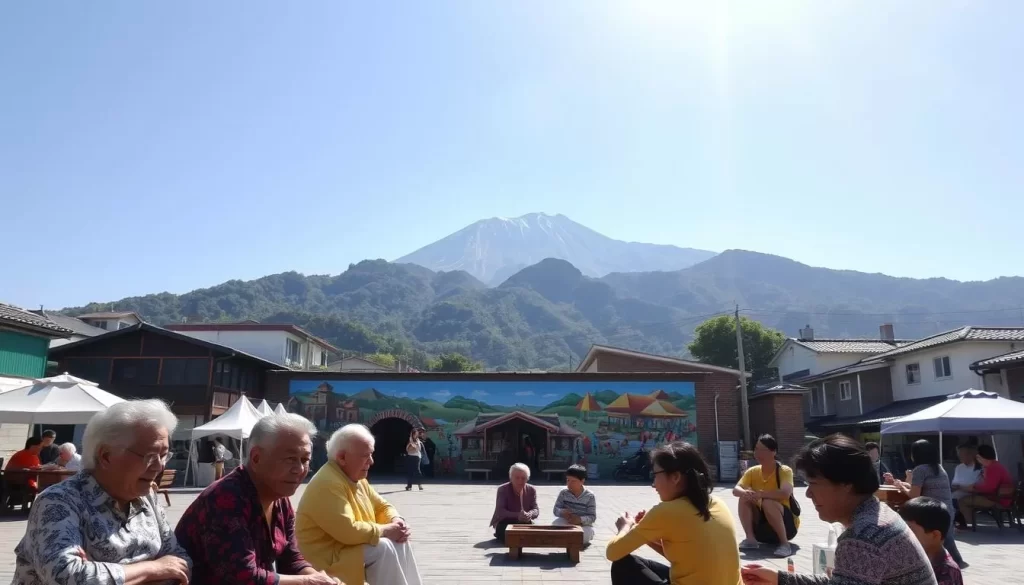
Challenges for Jejueo Survival
Jejueo, the indigenous language of Jeju Island, faces significant challenges to its survival. With a dwindling number of fluent speakers, largely due to urbanization and the dominance of Standard Korean, the language is considered endangered. Efforts to revitalize Jejueo must address these challenges head-on.
The influence of Standard Korean, particularly among younger generations, poses a significant threat. As more young people migrate to mainland South Korea for education and work, their exposure to and use of Jejueo diminishes. This shift not only affects the language’s vitality but also erodes its cultural significance.
Potential Revitalization Strategies
Despite the challenges, there are promising strategies for revitalizing Jejueo. Drawing inspiration from successful models like the Hawaiian language, which was revitalized through immersion programs, Jeju Island can adopt similar approaches. Language nests, or immersion preschools, can create environments where young children learn Jejueo naturally.
- Digital technologies, including interactive learning apps and online communities, can make learning Jejueo more engaging for younger generations.
- Integrating Jejueo into popular culture through music, film, and social media can change perceptions about its relevance and appeal.
- Economic incentives, such as preferential hiring for bilingual speakers in tourism, can motivate language acquisition and connect preservation to the island’s economic future.
By implementing these strategies, Jeju Island can work towards preserving its unique linguistic heritage. The future of Jejueo depends on concerted efforts from the community, government, and educational institutions.
Conclusion
As you conclude your exploration of Jeju Province’s linguistic landscape, the nuances of this unique region come into focus. You’ve now seen how Jeju Province, South Korea‘s southernmost province, is characterized by a complex interplay between Standard Korean and the indigenous Jejueo language.
The Jejueo language, despite its critical endangered status, holds significant cultural value, and various preservation initiatives are underway. These efforts range from government policies and educational programs to digital documentation and international collaborations, demonstrating a multifaceted approach to addressing language endangerment.
As you consider the future of languages in Jeju Province, it’s clear that while challenges are significant, there are pathways for ensuring this unique linguistic heritage isn’t lost. The growing awareness of Jejueo‘s cultural significance and lessons from successful language revitalization efforts elsewhere offer hope.
Today, Jeju Island stands at a linguistic crossroads, balancing its role as an international tourism destination with the preservation of its cultural and linguistic heritage. As you’ve learned from this article, the story of Jeju Province‘s languages reflects broader global challenges in maintaining linguistic diversity amidst modernization.
The above is subject to change.
Check back often to TRAVEL.COM for the latest travel tips and deals.


